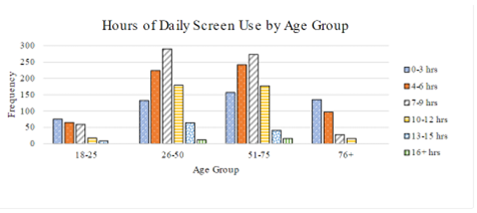Which of the following molecules exhibits ionic bonding?
NaCl
CO2
C6H12O6
H2O
Correct Answer : A
Sodium chloride exhibits lonic bonding due to the attraction between Na+ ions and Cl- ions.
Typically, elements on the opposite sides of the periodic table (a metal and a nonmetal) form ionic bonds. Carbon dioxide, water, and glucose exhibit covalent bonding. Typically, elements on the same side of the periodic table (two or more nonmetals) form covalent bonds.
TEAS 7 Exam Quiz Bank
HESI A2 Exam Quiz Bank
Find More Questions 📚
Teas 7 Questions: We got the latest updated TEAS 7 questions
100% Money Refund: 100% money back guarantee if you take our full
assessment pass with 80% and fail the actual exam.
Live Tutoring: Fully customized live tutoring lessons.
Guaranteed A Grade: All students who use our services pass with 90%
guarantee.
Related Questions
Correct Answer is C
Explanation
The percentage of respondents that indicated average screen usage between 4-12 hours per day is (628 +650+389) ÷ 2, 307 ≈0.723 or 72.3% This is indeed a significant majority of the responses and would be a reasonable conclusion. The highest screen usage is in the middle two groups with both the younger and older groups indicating less screen usage, so the daily usage neither increases nor decreases with age. While the oldest group shows the least usage per day, the survey data indicates that some of the Individuals over 75 do indeed use screens.

Correct Answer is D
Explanation
A hypothesis is the use of prior knowledge in order to provide a hypothetical explanation for why something may or may not occur. A hypothesis can be proved wrong or right based on the results of the experiment and repeated trials.
Correct Answer is D
Explanation
There are three types of proteins: fibrous, membrane, and globular. Fibrous or structural proteins consist of collagen, elastin, and keratin. Membrane proteins are interactive and anchored to a membrane. Globular proteins consist of functional proteins like enzymes, hemoglobin, and insulin.
Therefore unsaturated is the correct answer.
Correct Answer is A
Explanation
Two genes next to each other (or within a specified close distance) are said to be linked. Linked genes do not follow the law of Independent assortment because they are too close together to be segregated from each other in meiosis.
Correct Answer is D
Explanation
Liquids have no definite shape, but they do have a definite volume. While the particles of liquids move more freely than those in solids, they do maintain a definite volume.
Correct Answer is A
Explanation
This is a single replacement reaction in which copper replaces silver. The copper combines with the nitrate ions, and the silver precipitates out. Single replacement reactions have the general form of
A + BC → AC + B. Double replacement reactions have the general form of AB + CD→
AC + B. Double replacement reactions have the general form of AB + CD→ AD + CB. Synthesis reactions have the general form of A + B →
AD + CB. Synthesis reactions have the general form of A + B → AB. Decomposition reactions have the general form AB→
AB. Decomposition reactions have the general form AB→ A+B.
A+B.
Correct Answer is D
Explanation
A tissue contains a variety of cell types that work in conjunction to perform similar functions.
The cells are similar in structure despite being located throughout the body. There are four types of tissues in the human body: connective, epithelial, muscle, and nervous system tissues.
Correct Answer is A
Explanation
Sodium chloride exhibits lonic bonding due to the attraction between Na+ ions and Cl- ions.
Typically, elements on the opposite sides of the periodic table (a metal and a nonmetal) form ionic bonds. Carbon dioxide, water, and glucose exhibit covalent bonding. Typically, elements on the same side of the periodic table (two or more nonmetals) form covalent bonds.
Correct Answer is B
Explanation
Axons carry action potential in the direction of synapses. Axons are the long, fiber-like structures that carry information from neurons. Electrical impulses travel along the body of the axons, some of which are up to a foot long.
A neuron is a type of cell that is responsible for sending information throughout the body. There are several types of neurons, including muscle neurons, which respond to instructions for movement; sensory neurons, which transmit information about the external world; and interneurons, which relay messages between neurons. Myelin is a fat that coats the nerves and ensures the accurate transmission of information in the nervous system.
Correct Answer is C
Explanation
There are four different nucleotides in DNA. Nucleotides are monomers of nucleic acids, composed of five- carbon sugars, a phosphate group, and a nitrogenous base. Nucleotides make up both DNA and RNA. They are essential for the recording of an organism's genetic information, which guides the actions of the various cells of the body.
This question was extracted from the actual TEAS Exam. Ace your TEAS exam with the actual TEAS 7 questions, Start your journey with us today
Visit Naxlex, the Most Trusted TEAS TEST Platform With Guaranteed Pass of 90%.
Money back guarantee if you use our service and fail the actual exam. Option of personalised live tutor on your area of weakness.
